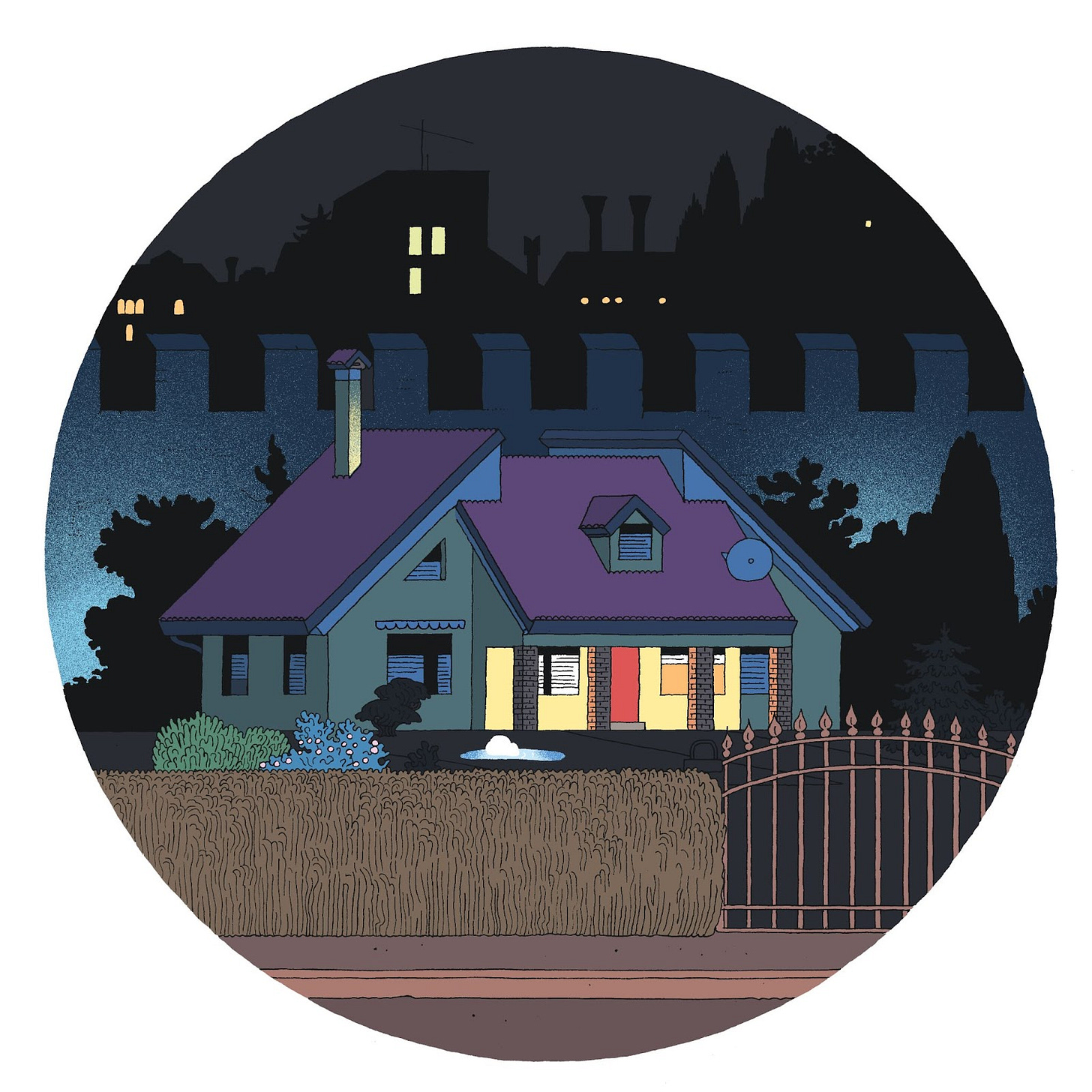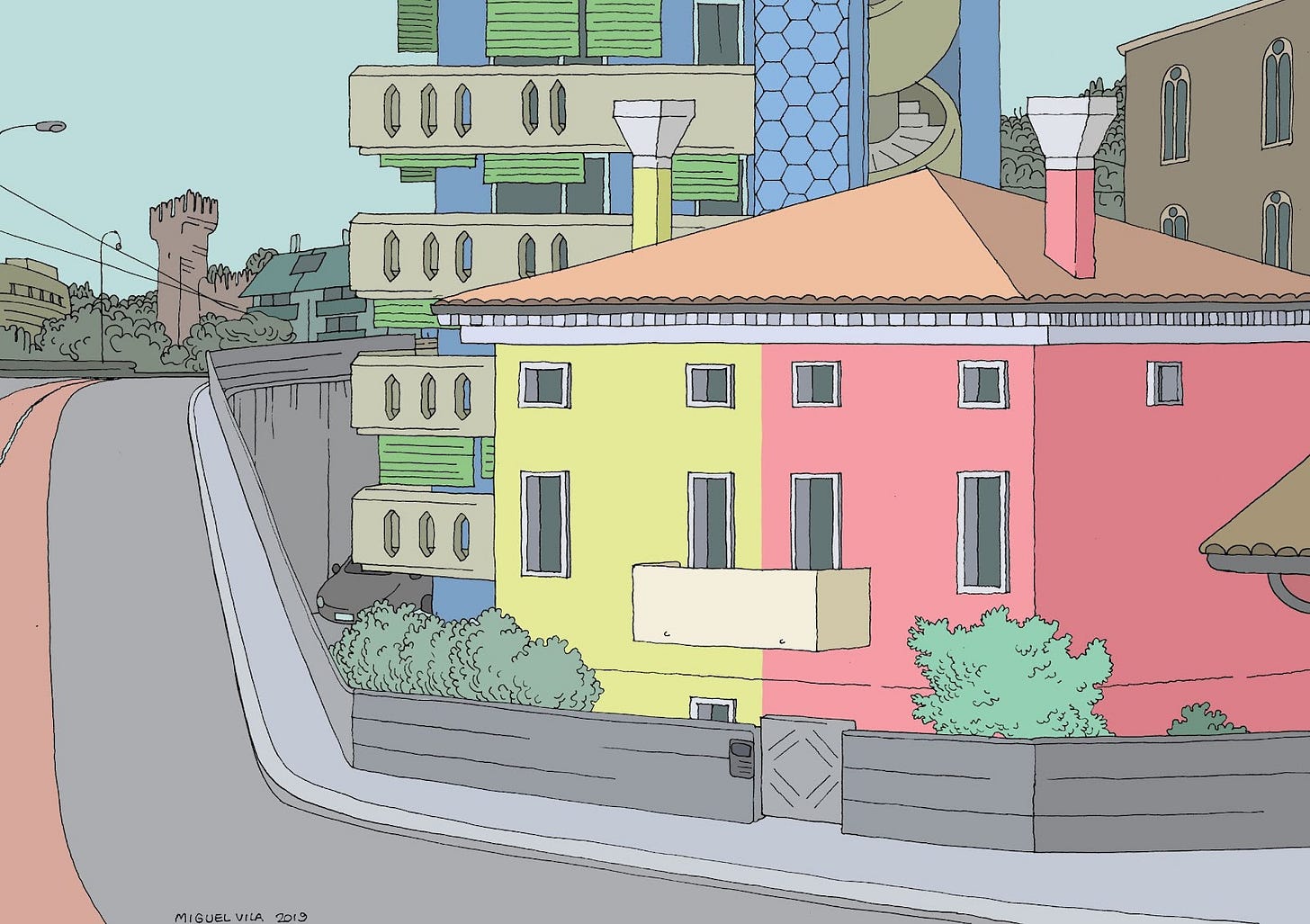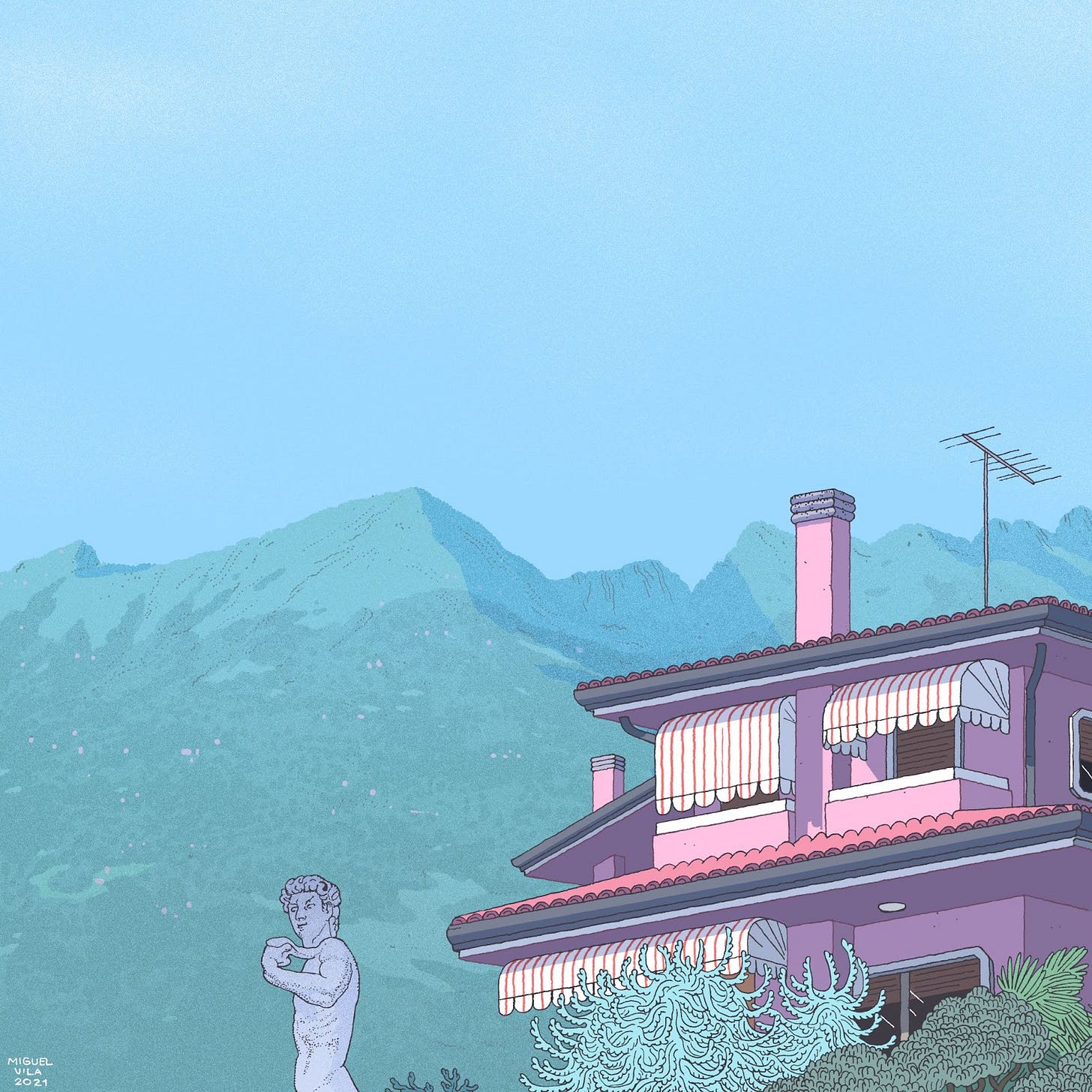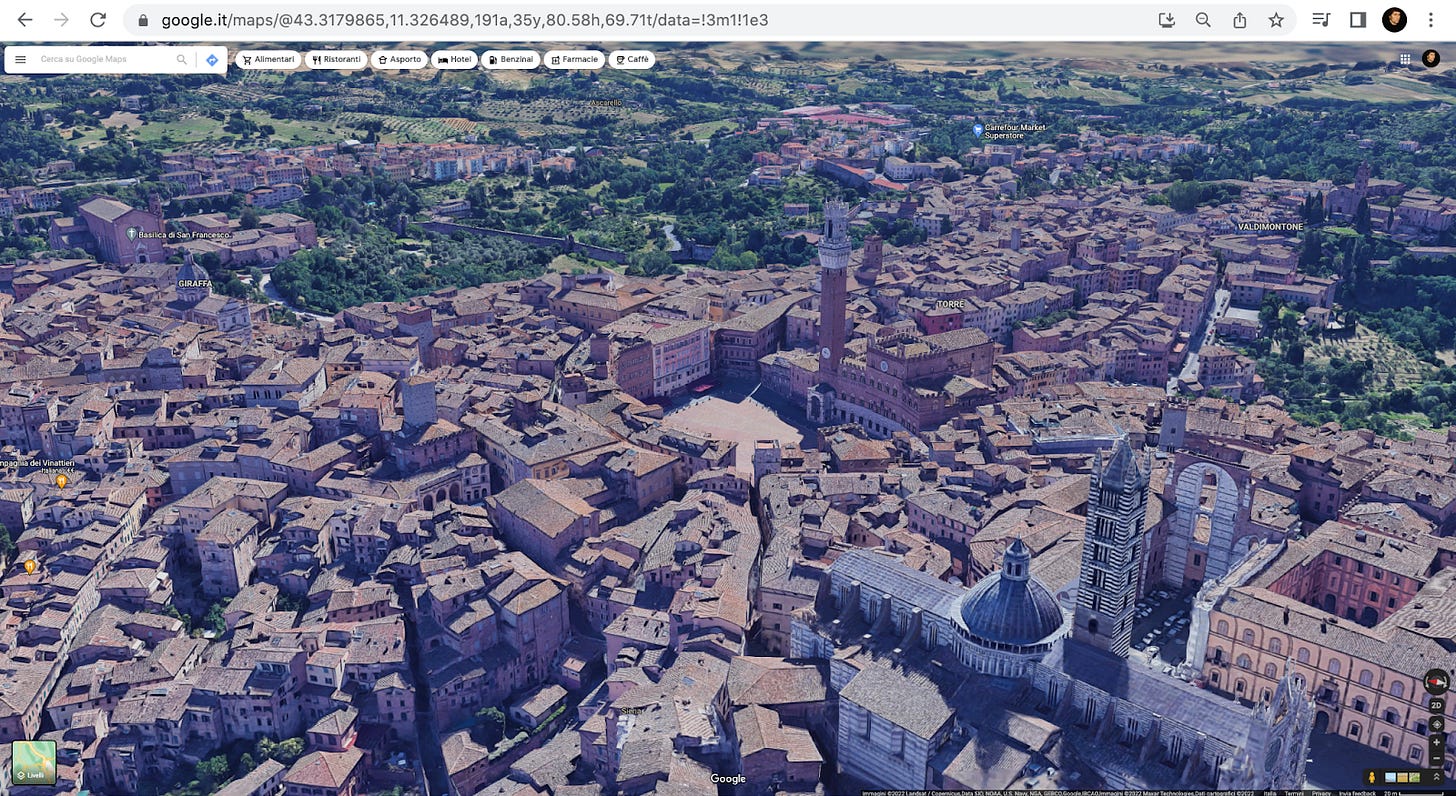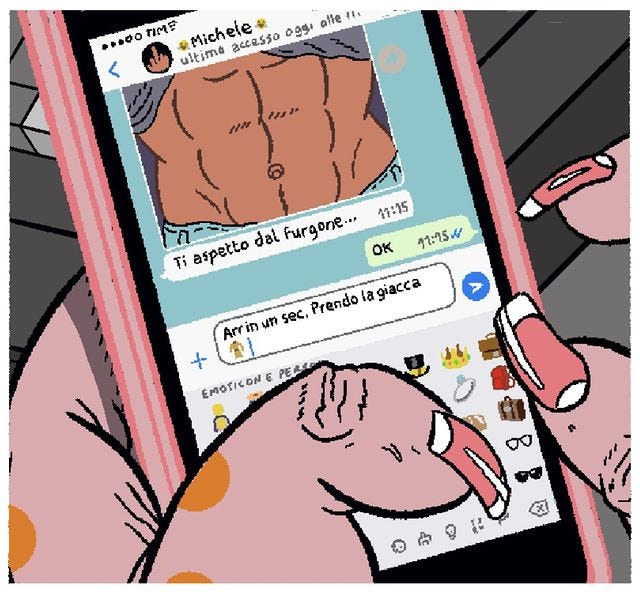Second Takeover of the season fellas. Let’s take a walk in the venetian suburbs…
Only for the Takeovers my text will be in italic, just to distinguish it from the guest’s. My name is Federico and welcome to Representations of Architecture #31.
(Gmail could chunk a part of this mail. Click “continue reading” to read the full version)
Intro
Miguel Vila is the rising star of the Italian graphic novel. With two (extraordinary) books in two years1 he has narrated small and squalid provincial stories with an incomparable graphic and compositional sensitivity. His characters are human beings full of flaws who move in urban scenarios that inevitably define them: a Venetian inland, where history and bland buildings blend into flat landscapes bordering on anonymity. Life seems to stagnate in those spaces, which Vila punctuates with a rhythm and compositions comparable to the best Chris Ware. The drawing style combines an initial analogue ink phase with a digital coloring which, through subtle solutions, creates a perfect amalgam. The reader is gradually introduced into the story, passing through broad axonometric views in which the eye is lost in search of details and then arriving at smaller and more intimate vignettes, which through unsuspected details describe the urban environment more than a thousand words. The city speaks, Miguel Vila listens to it (and then draws it).
Insights
Nice to meet you! My name is Miguel Vila and I am an Italian comic artist and illustrator. I have always reserved a particular interest in landscapes and everything that lies within them, therefore natural spaces and, above all, human architecture. I think there is a lot to say about just one territory, even when it doesn't seem to be telling us anything. Evolutions, regresses, stratifications, destructions, inconsistencies are all visible signs in a metropolis or in a small country town that, once you have learned to read them, tell us something about us or about themselves. And what they often tell are irrational aimless motions; in fact, when I design an invented city I am designing according to a mentality that rejects design itself, I have to identify with those imperfections that enrich the urban landscape. Such a territory is much more present in Europe whose millenary stratifications are proud tourist destinations known all over the world.
In this regard, I want to show you a drawing I made in 2019. My style has changed a lot since then (I had not yet opened my instagram profile), yet this remains one of my favorite imaginative glimpses. We are somewhere in the North-East of Italy. We see in the foreground what was once a stately villa (typical of the Venetian tradition) and which today has been “converted” into a vulgar semi-detached house.
How do we know? It was plastered with two bright colors, so much so that it looked like lemon and strawberry ice cream!
It's very simple: we are looking at a glorious past that has undergone something worse than destruction: disfigurement. For some it may be a comic scene, for others a cultural drama. My intent was to tell something without using human figures or their emotions. There is something fascinating in the redundant silence that only architecture can convey.
In this more recent illustration the focus is on our lives. We do not know what happened but it is certainly serious: perhaps an attack or a fatal accident to the detriment of someone who was just returning from the supermarket. We have no rethorical elements to show us what emotions to feel, only signs on the pavement in the suburbs, a signature of the crime. What could have been a simple background is a scenario where we feel a harmful aura without the protagonists of the scene being present.
In other cases I simply want to describe the identity of the territory from scratch: for example the subject here is the typical modern villa that populates the Venetian countryside. I do not want to judge it at all, my intent is rather to give a little attention to something as ungraceful as a provincial house. Whether we like it or not, this is our landscape today, let's hear what it has to tell us.
Very beautiful links
I would propose a site that everyone already knows: Google Maps.
Perhaps one of the sites where I spend the most time a day. The reasons are obvious: I'm in love with maps, I don't think there are more attractive abstract shapes in the world. Usually my friends make fun of me for this obsession of mine. It's strange because it's not about drawings detached from our lives: we walk on those maps. A city, albeit seen from above, remains the same city that we experience day after day; even more approaching Google Maps is necessary for anyone to rediscover a familiar place from a completely new point of view (once accessible only from the porthole of an airplane). Now, with the 3D rendering of a large part of the inhabited centers, the planimetric journey is made even more realistic, so much so that we can lower the perspective and observe the undulating reliefs of a medieval village, as it can be seen here in the digitized Siena of my Mac.
The next screenshots immortalize some of my favorite maps. It is interesting to grasp the "personality" that each city transmits, seen in its entirety between old and new.
Rome, how did she managed to explode to such conformation?
Padua, my hometown. The 16th century walls are still legible today.
Bologna, never seen such a dense historic center.
Cuneo, this is adorable: it has the shape of its name!2
Another site for which I had a long addiction is Nonograms. These are particular Japanese crosswords that are very difficult to solve and, no, they are not at all similar to the Italian ones.
Sweet IG pages
There are too many Instagram pages that I follow with pleasure. Some are by fellow artists, others are collections of old photos or Bohemian castles. Here a short list of all the profiles that come to mind:
+ @___bad_drones___, @act.of.mapping, @_alpraz_, @emilianoponzi, @ladysfortuna, @bastienvives, @pierluigi_scandiuzzi e @enricopantani
Misc
Let’s play a game:
Can you tell me which city is this?
A) Minsk, Belarus
B) Berlin, Germany
C) Paris, France
D) Edinburgh, United Kingdom
Well, thanks Miguel for your insights. Precious material 💎.
You can find his books on Canicola’s website (top of the nsl) with the hope to have an english edition soon.
If you enjoyed this newsletter don’t forget to forward it to a friend, like it, comment it and obviously subscribe if you haven’t done it yet.
See you next week with a cloudy newsletter.
Ciao ciao,
Federico
Padovaland (2020) and Fiordilatte (2021), both published by Bologna-based Canicola.
Cuneo it’s the name of the city but in italian also means “wedge”.




